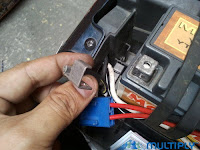Ben Katz has spent the last few months ripping apart and reassembling an old kick scooter to build what he describes as an all-terrain electric scooter. He's mixed in bits and pieces from robotics projects and mountain bikes, supersized the wheels, created custom shocks, built a novel disc brake, and added lots of aluminum to make a pretty sweet ride. He still has a few finishing touches to add but it's ready to roll, as you can see in the video after the jump.
A student of Atlanta's Paideia School and member of its robotics team, Katz was inspired to hit the workshop and remodel his scooter after getting up close to numerous electric vehicle builds from MIT research affiliate
Charles Guan at last year's Atlanta Mini Maker Faire. As luck would have it, he'd already managed to gather many of the necessary components for the modification when some old robotics projects got dismantled.
Construction began with the tearing apart of his well-used Royce Union Transit, which he says is a slightly better scooter than the ubiquitous Razor. To the basic frame, Katz added 12.5-inch (317.5 mm) wheels with knobby pneumatic tires, the rear also being fitted with a 60t sprocket salvaged from school, but before that could happen he needed to make new front and rear suspension assemblies.
The front fork came from an old mountain bike, to which custom-created shocks were fitted to form a leading link suspension arm. The rear also got some mountain bike action in the shape of two shock absorbers with 1500 lb/in springs. A motorless test run revealed some handling problems so Katz rebuilt the front fork, which slightly raised the angle of the deck but improved performance.
Next up, three CIM motors from dismantled robotics projects were hooked up to a reworked gearbox and encased in an aluminum housing before being mounted underneath the scooter's platform.
"The motor controller I am using (a Kelly KDS72200E controller rated for 120A continuous and 200A peak at up to 72V) is sealed within an aluminum enclosure, so it is safe from water and debris," Katz explained. "There are some exposed contacts, but they are between the deck and the battery case, so they are somewhat shielded. All that said, I would definitely not ride the scooter in the rain or through seriously wet conditions without at least adding fenders to prevent water from being slung into the scooter by the wheels."
Braking on kick scooters generally involves pushing a lever down onto the rear wheel and the Katz scooter also has a brake lever at the back of the platform, but it activates caliper grips positioned on either side of the rear sprocket to make a rather novel disc brake. The faithful mountain bike was again the donor for new handlebars, fitted with a hall effect twist grip throttle. Katz then bolted on a new custom deck made from carbon fiber bonded to a later of polycarbonate, and added a Hella master power switch.
In front of the motor and controller, underneath the deck, Katz mounted eight Turnigy 5000 mAh 4s Li-Pol battery packs in a 16S2P configuration (59.2V, 10 Ah) into an aluminum case fronted by a removable polycarbonate cover. While this may appear to leave them prone to off-road damage, Katz told us that's not necessarily true.
"The batteries are less exposed than they appear to be," he said. "I am using 'hardcase' lithium polymer batteries, which are already enclosed in a plastic shell. Additionally, the underside of the battery case is protected by a layer of polycarbonate. I do plan on completely enclosing the battery case later on though."
On the subject of keeping the batteries juiced up, he told us that "charging is very slow, but it is limited by my cheap charger, not the batteries. The scooter has a 600 watt-hour battery pack, and I have only a 50 watt charger, so if I drained the battery completely, it would take around 12 hours to charge. Typically, I don't drain the battery nearly that much, so it takes 3 - 4 hours. However, with a higher quality (and much more expensive) charger, the pack could be fully charged in 2 hours or less."
Although the all-terrain claims might just be a tad ambitious, the Katz mod will certainly manage to conquer many more off-road situations than the old kick scooter it used to be, and it zooms up to a top speed of 25 mph (40 km/h) without requiring any energetic pushing action from the rider.
"The range will vary drastically based on how aggressively and over what terrain it is ridden," said Katz. "I've been riding it about half on, half off road, and get about 8 miles per charge. On a flat road at a constant speed, it would probably go at least 12, although I have not tested those conditions."
"So far, I have tested the scooter on roads, rough dirt/mulch trails, and grass. As far as handling and traction, it works well on all the terrains I have tested it on. However, I have had some problems with the chain coming off the drive sprocket on large impacts, like when I ride over roots. I am currently adjusting the configuration of the sprockets to fix this problem."
Total build cost is reported to be around US$450, but Katz admits that he "got a significant number of the parts for free, so starting from scratch, the build would have cost at least twice that."



















